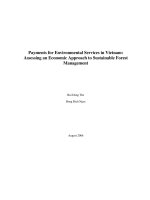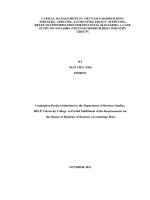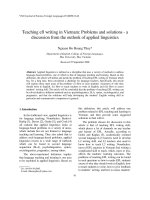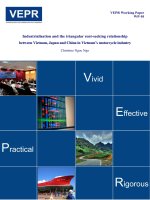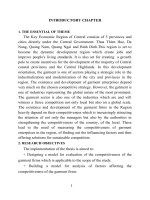Environmental issues in vietnam’s southern key economic zone after ten years of development
Bạn đang xem bản rút gọn của tài liệu. Xem và tải ngay bản đầy đủ của tài liệu tại đây (184.92 KB, 6 trang )
����������������������������������������������������������������������������������������������������������������������������������������������������������������������������������������������������������������������������������������������������������������������������������������������������������������������������������������������������������������������������������������������������������������������������������������������������������������������������������������������������������������������������������������������������������������������������������������������������������������������������������������������������������������������������������������������������������������������������������������������������������������������������������������������������������������������������������������������������������������������������������������������������������������������������������������������������������������������������������������������������������������������������������������������������������������������������������������������������������������������������������������������������������������������������������������������������������������������������������������������������������������������������������������������������������������������������������������������������������������������������������������������������������������������������������������������������������������������������������������������������������������������������������������������������������������������������������������������������������������������������������������������������������������������������������������������������������������������������������������������������������������������������������������������������������������������������������������������������������������������������������������������������������������������������������������������������������������������������������������������������������������������������������������������������������������������������������������������������������������������������������������������������������������������������������������������������������������������������������������������������������������������������������������������������������������������������������������������������������������������������������������������������������������������������������������������������������������������������������������������������������������������������������������������������������������������������������������������������������������������������������������������������������������������������������������������������������������������������������������������������������������������������������������������������������������������������������������������������������������������������������������������������������������������������������������������������������������������������������������������������������������������������������������������������������������������������������������������������������������������������������������������������������������������������������������������������������������������������������������������������������������������������������������������������������������������������������������������������������������������������������������������������������������������������������������������������������������������������������������������������������������������������������������������������������������������������������������������������������������������������������������������������������������������������������������������������������������������������������������������������������������������������������������������������������������������������������������������������������������������������������������������������������������������������������������������������������������������������������������������������������������������������������������������������������������������������������������������������������������������������������������������������������������������������������������������������������������������������������������������������������������������������������������������������������������������������������������������������������������������������������������������������������������������������������������������������������������������������������������������������������������������������������������������������������������������������������������������������������������������������������������������������������������������������������������������������������������������������������������������������������������������������������������������������������������������������������������������������������������������������������������������������������������������������������������������������������������������������������������������������������������������������������������������������������������������������������������������������������������������������������������������������������������������������������������������������������������������������������������������������������������������������������������������������������������������������������������������������������������������������������������������������������������������������������������������������������������������������������������������������������������������������������������������������������������������������������������������������������������������������������������������������������������������������������������������������������������������������������������������������������������������������������������������������������������������������������������������������������������������������������������������������������������������������������������������������������������������������������������������������������������������������������������������������������������������������������������������������������������������������������������������������������������������������������������������������������������������������������������������������������������������������������������������������������������������������������������������������������������������������������������������������������������������������������������������������������������������������������������������������������������������������������������������������������������������������������������������������������������������������������������������������������������������������������������������������������������������������������������������������������������������������������������������������������������������������������������������������������������������������������������������������������������������������������������������������������������������������������������������������������������������������������������������������������������������������������������������������������������������������������������������������������������������������������������������������������������������������������������������������������������������������������������������������������������������������������������������������������������������������������������������������������������������������������������������������������������������������������������������������������������������������������������������������������������������������������������������������������������������������������������������������������������������������������������������������������������������������������������������������������������������������������������������������������������������������������������������������������������������������������������������������������������������������������������������������������������������������������������������������������������������������������������������������������������������������������������������������������������������������������������������������������������������������������������������������������������������������������������������������������������������������������������������������������������������������������������������������������������������������������������������������������������������������������������������������������������������������������������������������������������������������������������������������������������������������������������������������������������������������������������������������������������������������������������������������������������������������������������������������������������������������������������������������������������������������������������������������������������������������������������������������������������������������������������������������������������������������������������������������������������������������������������������������������������������������������������������������������������������������������������������������������������������������������������������������������������������������������������������������������������������������������������������������������������������������������������������������������������������������������������������������������������������������������������������������������������������������������������������������������������������������������������������������������������������������������������������������������������������������������������������������������������������������������������������������������������������������������������������������������������������������������������������������������������������������������������������������������������������������������������������������������������������������������������������������������������������������������������������������������������������������������������������������������������������������������������������������������������������������������������������������������������������������������������������������������������������������������������������������������������������������������������������������������������������������������������������������������������������������������������������������������������������������������������������������������������������������������������������������������������������������������������������������������������������������������������������������������������������������������������������������������������������������������������������������������������������������������������������������������������������������������������������������������������������������������������������������������������������������������������������������������������������������������������������������������������������������������������������������������������������������������������������������������������������������������������������������������������������������������������������������������������������������������������������������������������������������������������������������������������������������������������������������������������������������������������������������������������������������������������������������������������������������������������������������������������������������������������������������������������������������������������������������������������������������������������������������������������������������������������������������������������������������������������������������������������������������������������������������������������������������������������������������������������������������������������������������������������������������������������������������������������������������������������������������������������������������������������������������������������������������������������������������������������������������������������������������������������������������������������������������������������������������������������������������������������������������������������������������������������������������������������������������������������������������������������������������������������������������������������������������������������������������������������������������������������������������������������������������������������������������������������������������������������������������������������������������������������������������������������������������������������������������������������������������������������������������������������������������������������������������������������������������������������������������������������������������������������������������������������������������������������������������������������������������������������������������������������������������������������������������������������������������������������������������������������������������������������������������������������������������������������������������������������������������������������������������������������������������������������������������������������������������������������������������������������������������������������������������������������������������������������������������������������������������������������������������������������������������������������������������������������������������������������������������������������������������������������������������������������������������������������������������������������������������������������������������������������������������������������������������������������������������������������������������������������������������������������������������������������������������������������������������������������������������������������������������������������������������������������������������������������������������������������������������������������������������������������������������������������������������������������������������������������������������������������������������������������������������������������������������������������������������������������������������������������������������������������������������������������������������������������������������������������������������������������������������������������������������������������������������������������������������������������������������������������������������������������������������������������������������������������������������������������������������������������������������������������������������������������������������������������������������������������������������������������������������������������������������������������������������������������������������������������������������������������������������������������������������������������������������������������������������������������������������������������������������������������������������������������������������������������������������������������������������������������������������������������������������������������������������������������������������������������������������������������������������������������������������������������������������������������������������������������������������������������������������������������������������������������������������������������������������������������������������������������������������������������������������������������������������������������������������������������������������������������������������������������������������������������������������������������������������������������������������������������������������������������������������������������������������������������������������������������������������������������������������������������������������������������������������������������������������������������������������������������������������������������������������������������������������������������������������������������������������������������������������������������������������������������������������������������������������������������������������������������������������������������������������������������������������������������������������������������������������������������������������������������������������������������������������������������������������������������������������������������������������������������������������������������������������������������������������������������������������������������������������������������������������������������������������������������������������������������������������������������������������������������������������������������������������������������������������������������������������������������������������������������������������������������������������������������������������������������àng Nai River,
cutting water pollution in Thò Vaûi River, and
processing industrial hazardous waste, etc.
b. Preventing harmful effects on the
environment:
6
2008 Report of Ñoàng Nai IP Management Board
36
RESEARCHES & DISCUSSIONS
Environmental protection should be mainly
based on efforts to prevent and limit adverse
effects on the environment. Consequently, local
authorities should insistently require measures to
protect the environment from all investment
projects before granting license, and then, when
conditions are favorable, limit and ban projects
that may produce severe impacts on or pose
latent risks to the environment. Furthermore,
industrial
concerns
that
fail
to
meet
environmental standards should be prohibited
from operation.
Fundamental
investigations
should
be
promoted to pinpoint the sources of pollution,
especially in key areas. It is also advisable to
establish Centers for Environmental Monitoring
and Technology to monitor, analyze, evaluate and
forecast changes in environmental elements,
thereby suggesting timely measures to block
sources of pollutants and rescue and handle
environmental
incidents.
Additionally,
application and development of clean and ecofriendly technologies should be encouraged.
Finally, it is of necessity to research and apply
pollution treatment technologies particularly in
centralized IPs and urban areas.
c. Promoting public participation and
applying
economic
measures
in
environmental protection:
Favorable conditions for participation of
organizations
and
individuals,
especially
producers, in environmental activities should be
created. Encouragement should be given to
potential suppliers of environmental protecting
services, particularly waste collection, recycling
and treatment.
Aside from administrative measures and
educational
probation
of
environmental
protection, economic measures should also be
employed. This should be done on the principle
that “Anyone who does harm to the environment
must
pay
compensation.”
Moreover, all
environmental regulations should be observed
regarding paying environmental fees for wastes,
paying deposit to environmental restoration fund
ECONOMIC DEVELOPMENT
No. 207, November 2011
for mining activities, paying damages for
activities causing harms for the ecosystem, etc.
d. Promoting investment in
environmental protection:
It is essential, as required by Resolution 41NQ/TW of the Politburo, “to eradicate the
overestimation of socioeconomic development and
underestimation of environmental protection and
regards investment in environmental protection
as a solution for sustainable development.”
Moreover, an increase in public expenditure on
environmental protection should be considered so
that it will account for no less than 1% of total
budget spending. This rate should also be raised
in accordance with economic growth, according to
instructions by the Politburo (in Resolution 41NQ/TW) and the Prime Minister (in Decision
34/2005/QĐ-TT dated Feb. 22, 2005). There is
another need to take measures to exploit private
investment
and
financial
support
from
international organizations in environmental
protection. Funds for environmental protection
should be employed effectively and economically
by prioritizing construction of environmental
infrastructure, promoting activities of the
Environmental Protection Funds, enhancing
environmental monitoring and supervision, and
boosting public awareness of environmental
protection.
Environmental protection is an obligation that
not only plays a significant part in guaranteeing
public health but also greatly contributes to
socioeconomic development in KEZs. This
responsibility is so complicated and urgent that it
requires attention and instructions from
authorities,
strict
state
control,
active
participation of the Fatherland Front and
relevant agencies as well as reponse from the
residents in SKEZ. Additionally, a detailed action
plan should be made immediately for making
postive and dramatic changes in environmental
protection. Finally, a resolution should be
proposed to turn SKEZ into an EZ with
sustainable development that ensures the
harmony of economic growth, progress, and
social equality, resulting in a good living
environment
References
1. Đồng Nai IP Management Board (2008), Annual Report.
2. HCMC Department of Natural Resources and Environment (2008), A report on environmental issues.
3. Ministry of Planning and Investment (2006), “Báo cáo tổng hợp đề án Quy hoạch tổng thể phát triển kinh tế - xã
hội Vùng Đông Nam bộ và Vùng kinh tế trọng điểm phía Nam đến năm 2020”, (General Report on Project for Socioeconomic Development of Eastern South Vietnam and Southern Key Economic Zone until 2020), Hà Nội
4. Ministry of Planning and Investment (2003), “Báo cáo một số nét chủ yếu về tình hình kinh tế - xã hội và các giải
pháp thúc đẩy phát triển vùng kinh tế trọng điểm phía Nam” (Report on socioeconomic situation and solutions for
economic development of Southern Key Economic Zone)
5. Ministry of Planning and Investment & Institution for Development Strategies (2000), “Báo cáo kết quả phát triển
3 vùng kinh tế trọng điểm và quan hệ với các vùng khác” (Report on development of three KEZs and their relations with
other zones), Hà Nội.
6. Prime Minister (1998), Decision 44/1998/QĐ-TTg dated Feb. 23, on Approval of Socio-economic Development of
Southern Key Economic Zone until 2010.
7. Sài gòn Giải phóng, June 22, 2007.
8. Thời báo Kinh tế Việt Nam, Feb. 5, 2011.
RESEARCHES & DISCUSSIONS
37


